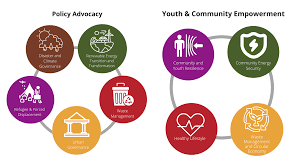The Power of Collaborative Efforts
Collaborative efforts have long been recognized as a driving force behind innovation and progress. When individuals or organizations come together to work towards a common goal, the results can be truly transformative.
One of the key benefits of collaboration is the pooling of diverse talents and expertise. By bringing together individuals with different skills and perspectives, collaborative efforts can lead to more creative solutions and approaches that may not have been possible otherwise.
Furthermore, collaborative efforts often result in increased efficiency and productivity. When people work together towards a shared objective, tasks can be divided based on individual strengths, leading to faster progress and better outcomes.
Collaboration also fosters a sense of community and mutual support. Working towards a common goal creates bonds between participants, fostering trust and camaraderie that can extend beyond the immediate project at hand.
In today’s interconnected world, collaborative efforts are more important than ever. With technology enabling people to connect and collaborate across distances, the potential for impactful collaboration has never been greater.
Whether it’s in business, academia, or social causes, the power of collaborative efforts cannot be underestimated. By working together towards shared goals, we can achieve remarkable results that benefit not only individuals but society as a whole.
8 Benefits of Collaboration: Unleashing Creativity, Efficiency, and Synergy in Team Efforts
- Enhanced creativity and innovation through diverse perspectives.
- Increased efficiency by leveraging individual strengths.
- Fosters a sense of community and mutual support among participants.
- Opportunity to learn from others and acquire new skills.
- Shared resources lead to cost savings and improved resource utilization.
- Allows for tackling complex challenges that may be beyond the capacity of individuals alone.
- Promotes synergy where the combined efforts result in outcomes greater than the sum of individual contributions.
- Builds strong networks and relationships that can lead to future collaborations and opportunities.
Four Downsides of Collaborative Efforts: Decision-Making Hurdles, Conflict Potential, Coordination Challenges, and Risk of Unequal Participation
- Difficulties in decision-making due to multiple stakeholders having different priorities and opinions.
- Potential for conflicts and disagreements among collaborators, which can hinder progress.
- Challenges in coordinating schedules and communication across diverse teams or individuals.
- Risk of unequal contributions where some participants may not pull their weight, leading to imbalance.
Enhanced creativity and innovation through diverse perspectives.
Collaborative efforts bring about enhanced creativity and innovation through diverse perspectives. When individuals with different backgrounds, expertise, and viewpoints come together to tackle a problem or pursue a goal, they bring a wealth of unique ideas and insights to the table. This diversity of perspectives sparks creativity, leading to the generation of innovative solutions that may not have been possible if each person had worked in isolation. By embracing and leveraging these varied viewpoints, collaborative teams can push boundaries, think outside the box, and ultimately achieve breakthroughs that drive progress and success.
Increased efficiency by leveraging individual strengths.
Collaborative efforts lead to increased efficiency by leveraging individual strengths. When individuals come together to work towards a common goal, they can assign tasks based on each person’s unique skills and expertise. This division of labor ensures that each team member is contributing in their area of strength, leading to faster progress and higher-quality outcomes. By tapping into the diverse talents of team members, collaborative efforts optimize productivity and streamline processes, ultimately achieving results that surpass what any individual could accomplish alone.
Fosters a sense of community and mutual support among participants.
Collaborative efforts have a remarkable ability to foster a sense of community and mutual support among participants. When individuals come together to work towards a common goal, they build connections and relationships that go beyond the project itself. This sense of community creates a supportive environment where team members can rely on each other, share ideas openly, and celebrate successes together. Through collaboration, participants not only achieve their objectives but also cultivate a strong bond that enhances teamwork and encourages continued cooperation in future endeavors.
Opportunity to learn from others and acquire new skills.
Collaborative efforts provide a valuable opportunity for individuals to learn from others and acquire new skills. By working alongside people with diverse backgrounds and expertise, individuals can gain insights, knowledge, and techniques that they may not have encountered otherwise. This exposure to different perspectives not only broadens one’s understanding but also enhances their own skill set, fostering personal growth and development. Through collaboration, individuals have the chance to expand their capabilities, adapt to new challenges, and ultimately become more versatile and well-rounded contributors in any endeavor.
Shared resources lead to cost savings and improved resource utilization.
When individuals or organizations engage in collaborative efforts, they can benefit from shared resources that lead to cost savings and improved resource utilization. By pooling together resources such as funding, equipment, expertise, and manpower, collaborators can achieve economies of scale and avoid unnecessary duplication of efforts. This not only helps in reducing overall costs but also ensures that resources are utilized more efficiently, maximizing their impact and effectiveness towards achieving common goals.
Allows for tackling complex challenges that may be beyond the capacity of individuals alone.
Collaborative efforts enable the tackling of complex challenges that may exceed the capacity of individuals working alone. By bringing together diverse perspectives, expertise, and resources, collaborative teams can approach intricate problems with a comprehensive and multifaceted strategy. This collective approach allows for the pooling of knowledge and skills, leading to innovative solutions that address the complexities of the challenge at hand. In essence, collaborative efforts empower individuals to combine their strengths and work together towards overcoming obstacles that would be insurmountable on an individual basis.
Promotes synergy where the combined efforts result in outcomes greater than the sum of individual contributions.
Collaborative efforts promote synergy by harnessing the collective power of individuals working together towards a common goal. In these collaborations, the combined efforts and diverse perspectives of team members often lead to outcomes that surpass what any individual could achieve alone. By leveraging each person’s strengths and expertise, collaborative teams can generate innovative ideas, solve complex problems, and achieve results that are truly greater than the sum of their individual contributions.
Builds strong networks and relationships that can lead to future collaborations and opportunities.
Collaborative efforts play a crucial role in building strong networks and relationships that pave the way for future collaborations and opportunities. By working together towards a common goal, individuals and organizations forge connections based on shared experiences, trust, and mutual respect. These relationships not only enhance the current project but also lay the foundation for future partnerships and endeavors. The networks formed through collaboration serve as valuable resources for accessing new opportunities, sharing knowledge, and expanding reach, ultimately creating a ripple effect of positive outcomes in various spheres of work and life.
Difficulties in decision-making due to multiple stakeholders having different priorities and opinions.
In collaborative efforts, one significant challenge arises from the complexities of decision-making when multiple stakeholders with varying priorities and opinions are involved. Navigating through divergent viewpoints and conflicting agendas can often lead to prolonged discussions, delays in reaching consensus, and potential disagreements that may hinder progress. Balancing the needs and interests of all stakeholders while trying to make collective decisions can be a daunting task, requiring effective communication, negotiation skills, and a willingness to compromise in order to move forward towards common goals.
Potential for conflicts and disagreements among collaborators, which can hinder progress.
One significant con of collaborative efforts is the potential for conflicts and disagreements among collaborators, which can hinder progress. When individuals with differing opinions, priorities, or working styles come together to collaborate on a project, there is a risk of interpersonal tensions arising. These conflicts can lead to delays in decision-making, decreased productivity, and overall discord within the team. Resolving these disagreements requires time and effort that could otherwise be dedicated to advancing the project, making it crucial for collaborators to effectively communicate and find common ground in order to mitigate this obstacle to success.
Challenges in coordinating schedules and communication across diverse teams or individuals.
One significant challenge in collaborative efforts is the difficulty of coordinating schedules and communication across diverse teams or individuals. With team members located in different time zones or having varying work hours, finding a mutually convenient time for meetings or discussions can be a logistical nightmare. Additionally, differences in communication styles, language barriers, or cultural norms can lead to misunderstandings and inefficiencies in conveying information effectively. These challenges can hinder the smooth flow of collaboration and require careful planning and coordination to overcome.
Risk of unequal contributions where some participants may not pull their weight, leading to imbalance.
In collaborative efforts, one significant con is the risk of unequal contributions among participants, where some individuals may not pull their weight effectively, leading to an imbalance in the workload distribution. This disparity can result in frustration and resentment among team members who feel that they are carrying a disproportionate burden compared to others. It may also hinder the overall progress of the project as certain tasks remain unfinished or poorly executed due to inadequate contribution from some participants. Addressing and managing this issue of unequal contributions is crucial to maintaining a harmonious and productive collaborative environment.




